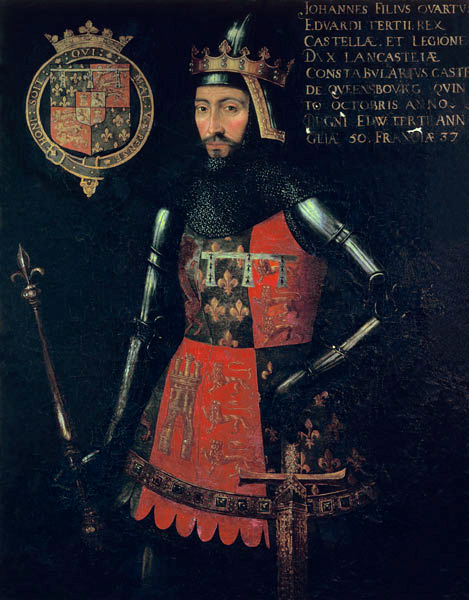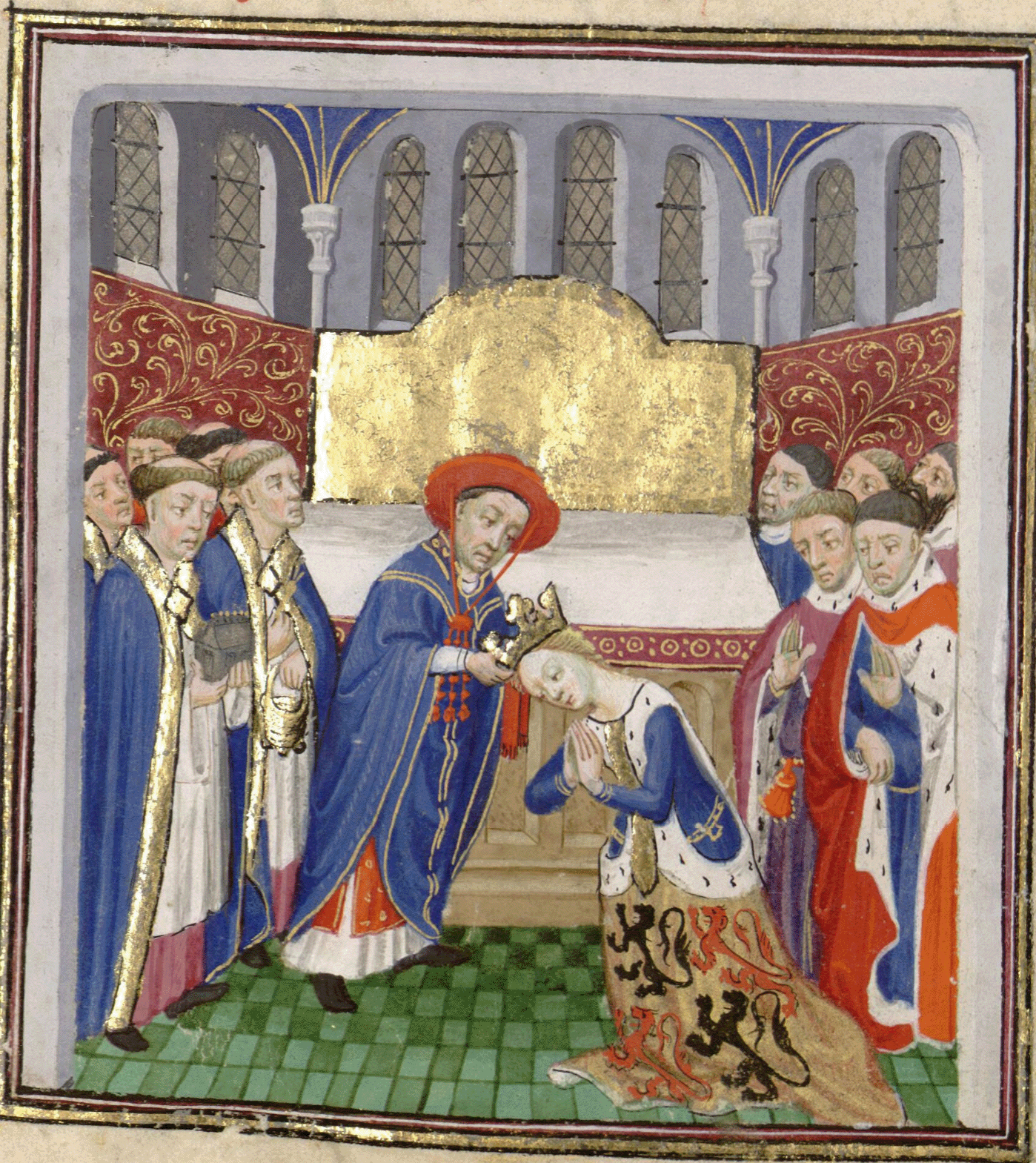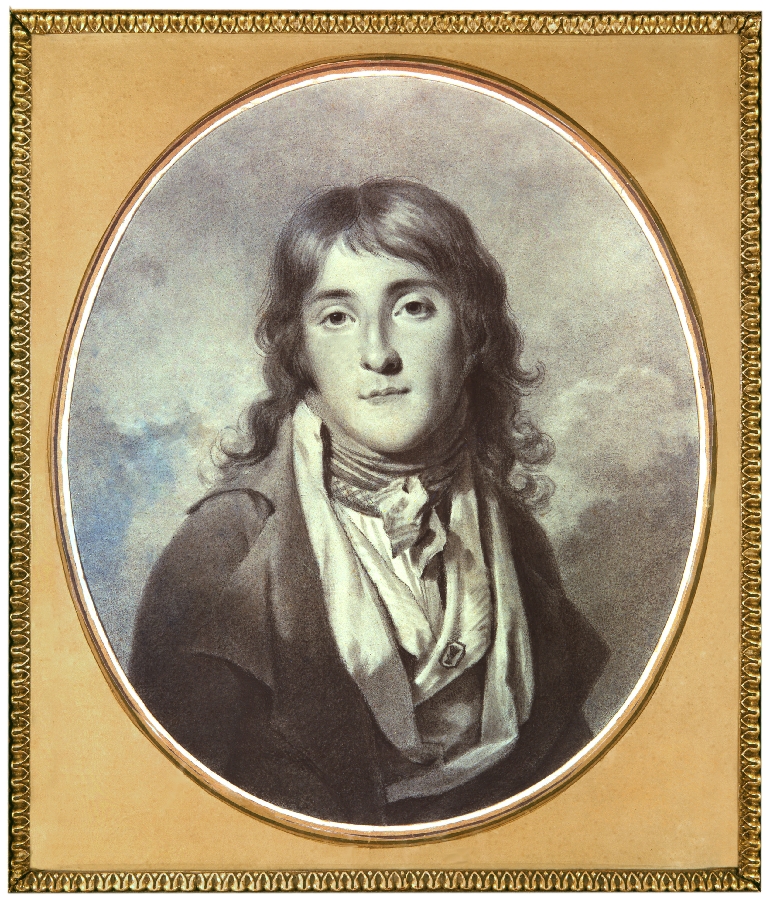by Susan Flantzer
© Unofficial Royalty 2022

Cardinal Henry Beaufort, Bishop of Winchester; Credit – Wikipedia
Henry Beaufort was an English prelate and statesman who was Bishop of Lincoln (1398 – 1404), Bishop of Winchester (1404 – 1447), a Cardinal of the Roman Catholic Church (1426 – 1447), and Lord Chancellor of England three times (1403 – 1405, 1413 – 1417, and 1424 – 1426). Born circa 1375, Henry Beaufort was the second of the three sons and the second of the four children of John of Gaunt, 1st Duke of Lancaster and his mistress Katherine Swynford, whom he later married as his third wife in 1396. The surname of Henry and his three siblings is derived from the now-demolished Beaufort Castle, a property in Champagne, France that John of Gaunt had sold years before. John of Gaunt likely felt it was a safe name to give to his illegitimate children by Katherine Swynford.
All British monarchs since King Henry IV are descended from Henry’s father John of Gaunt. In fact, most European monarchies are descended from John. The Houses of Lancaster, York, and Tudor were all descended from John of Gaunt’s children:
- King Henry IV (Lancaster: father of King Henry V, grandfather of King Henry VI)
- Joan Beaufort (York: grandmother of King Edward IV and King Richard III)
- John Beaufort (Tudor: great-grandfather of King Henry VII)
During the Wars of the Roses, the battle for the English throne pitted the House of Lancaster and the House of York against each other.

Henry’s father John of Gaunt, 1st Duke of Lancaster; Credit – Wikipedia
Henry Beaufort’s paternal grandparents were King Edward III of England and Philippa of Hainault, Queen of England. His maternal grandmother is unknown but his maternal grandfather was Paon de Roet, a knight from the County of Hainault (now part of Belgium and France) who first came to England in 1328 when Philippa of Hainault married King Edward III of England.

Henry’s mother Katherine Swynford; Credit – http://kettlethorpechurch.co.uk/katherine-swynford/
Henry had three siblings:
- John Beaufort, 1st Earl of Somerset (circa 1373 – 1410), married Margaret Holland, had six children. The Tudor dynasty was directly descended from John as he was the great-grandfather of King Henry VII of England. John’s daughter Joan Beaufort married James I, King of Scots, and was an ancestor of the Scots House of Stuart and the English House of Stuart.
- Thomas Beaufort, Duke of Exeter (circa 1377–1426), married Margaret Neville of Horneby, one son who died young
- Joan Beaufort, Countess of Westmorland (circa 1379–1440), married (1) Robert Ferrers, 5th Baron Boteler of Wem, had two daughters (2) Ralph de Neville, 1st Earl of Westmorland, had fourteen children. Through her daughter Cecily Neville, Joan was the maternal grandmother of two English kings from the House of York, the brothers King Edward IV and King Richard III.
Henry had three half-siblings from his mother’s first marriage to Sir Hugh Swynford (circa 1340 – 1371), a knight in service to John of Gaunt:
- Blanche Swynford (1367 – circa 1374), died in childhood
- Sir Thomas Swynford (1368 – 1432), married (1) Jane Crophill, had three children (2) Margaret Grey, no children
- Margaret Swynford (born c. 1369), became a nun at Barking Abbey in 1377 with help from her future stepfather John of Gaunt, where she lived the religious life with her cousin Elizabeth Chaucer, daughter of the poet Geoffrey Chaucer and Katherine’s sister Philippa de Roet

King Henry IV of England, Henry’s half-brother from his father’s first marriage to Blanche of Lancaster; Credit – Wikipedia
Henry had seven half-siblings from his father’s first marriage to the wealthy heiress Blanche of Lancaster:
- Philippa of Lancaster, Queen of Portugal (1360 – 1415), married King João I of Portugal, had nine children
- John of Lancaster (c.1362/1364), died in infancy
- Elizabeth of Lancaster (1364 – 1426), married (1) John Hastings, 3rd Earl of Pembroke (2) John Holland, 1st Duke of Exeter, had six children (3) John Cornwall, 1st Baron Fanhope, had two children
- Edward of Lancaster (born and died 1365)
- John (born and died 1366), died in early infancy
- King Henry IV of England (1367 – 1413), married (1) Mary de Bohun, had six children including King Henry V of England (2) Joanna of Navarre, no children
- Isabella of Lancaster (born 1368), died young

The effigy of Catherine of Lancaster, Queen of Castile, Henry’s half-sister from his father’s second marriage to Constance of Castile; Credit – Wikipedia
Henry had two half-siblings from his father’s second marriage to Infanta Constance of Castile:
- Catherine of Lancaster, Queen of Castile (1372 – 1418), married King Enrique III of Castile and León, had three children. Through their son Juan II of Castile, Catherine and Enrique III are the grandparents of Isabella I, Queen of Castile and great-grandparents of Catherine of Aragon (daughter of Isabella I of Castile and Ferdinand II of Aragon), the first wife of King Henry VIII of England.
- John of Lancaster (1374 – 1375), died in infancy
Henry and his siblings likely spent their early years at Kettlethorpe Hall in Kettlethorpe, Lincolnshire, England, a property that had belonged to the first husband of Henry’s mother, Sir Hugh Swynford, who had died in 1371. Kettlethorpe was a small, quiet village, close to the city of Lincoln but 150 miles from London. It would have been a perfect place for John of Gaunt to carry on a discreet affair and have his illegitimate children raised as he had made a second marriage in 1371 and Katherine was a recent widow.
Two years after the death of his second wife Constance of Castile, John of Gaunt married his mistress Katherine Swynford, Henry Beaufort’s mother, on January 13, 1396, at Lincoln Cathedral in England. After the marriage of Katherine and John, their four children were legitimized by both John of Gaunt’s nephew King Richard II of England and Pope Boniface IX. After Henry Bolingbroke, John of Gaunt’s eldest son by his first wife Blanche of Lancaster, deposed his first cousin King Richard II in 1399, and became King Henry IV, he inserted the Latin phrase excepta regali dignitate (except royal status) in the documents that had legitimized his Beaufort half-siblings and supposedly that phrase barred them from the throne. However, many disputed and still dispute the authority of a monarch to alter an existing parliamentary statute on his or her own authority, without the further approval of Parliament.
John of Gaunt treated his Beaufort children as cherished members of the family but he was careful that the provisions he made for them would not interfere with the Lancaster inheritance reserved for his legitimate children. Instead, he found other forms of income for them through marriages and for his second son Henry, through the church. Because of John of Gaunt’s cautions, his Beaufort children were held in great affection by their half-siblings.
Henry was destined from an early age to have a career in the Roman Catholic Church. At that time in the Church, there were benefices, ecclesiastical offices that bestowed an income on its holder. A prebend was a type of benefice connected with a cathedral or a collegiate church (a church administered by a chapter of canons). In January 1390, when Henry was about fifteen years old, he was given the wealthy prebend of Thame in the Diocese of Lincoln. In August 1390, Henry had been given the prebend of Riccall in the Diocese of York. The additional wealthy prebend of Sutton in the Diocese of Lincoln was given to Henry in January 1391.
It was not at all unusual for teenagers to be granted church offices at this time. The benefices would provide for Henry’s living expenses and his education. Beginning in the academic year of 1390 – 1391, Henry attended Queens College at the University of Oxford to study civil and canon law. After his year at Oxford, Henry was sent to Aachen, a Free Imperial City of the Holy Roman Empire, now in the German state of North Rhine-Westphalia, to continue his studies in civil and canon law.
In 1397, Pope Boniface IX issued a papal bull making twenty-two-year-old Henry Beaufort the Dean of Wells Cathedral in Somerset, England, most likely at the request of Henry’s father John of Gaunt. It was at this time that John of Gaunt pressed Pope Boniface IX to legitimize his four children by his former mistress Katherine Swynford whom he had married in 1396. The pope was more than eager to grant the influential John of Gaunt, Duke of Lancaster his wish. In early April 1397, Henry was ordained as a deacon, and later that month, he was appointed Chancellor of Oxford University.
On February 27, 1398, in a move that astounded many, twenty-one-year-old Henry was named Bishop of Lincoln by his first cousin King Richard II of England who had received a papal bull from Pope Boniface IX instructing him to do so. Despite thirty being the required age for bishops, John of Gaunt had again pressed Pope Boniface IX, and again wishing to gain favor with John of Gaunt, the pope agreed. Henry resigned from the position of Chancellor of Oxford University and on July 14, 1398, he was consecrated as Bishop of Lincoln.
Henry Beaufort, while Bishop of Lincoln, fathered an illegitimate daughter with an unknown woman. Jane Beaufort and her husband Sir Edward Stradling were both named in Beaufort’s will. Sir Edward held several government positions over the years which he may have owed to the influence of his father-in-law.
- Jane Beaufort (1402 – 1453), married Sir Edward Stradling, had one son and one daughter
In 1403, four years after his half-brother Henry Bolingbroke deposed their mutual first cousin King Richard II and became King Henry IV, Henry Beaufort was appointed Lord Chancellor of England for the first of three times. On November 14, 1404, he was appointed Bishop of Winchester. Henry Beaufort was a trusted advisor to his half-brother King Henry IV (reigned 1399 – 1413) and his nephew King Henry V (reigned 1413 – 1422). He played an important role in English history during the first half of the fifteenth century and became extremely wealthy and influential in the process.

King Henry V of England; Credit – Wikipedia
In 1421, King Henry V named Henry Beaufort the godfather of his only child, the future King Henry VI. On August 31, 1422, thirty-five-year-old King Henry V, a warrior king, the victor against the French at the Battle of Agincourt, determined to conquer France once and for all, succumbed to dysentery, a disease that killed more soldiers than battle, leaving a nine-month-old son to inherit his throne. The infant King Henry VI was entrusted to the care of his great uncles, Henry Beaufort, Bishop of Winchester and Thomas Beaufort, Duke of Exeter.

King Henry VI’s accession – It is likely that Henry Beaufort is in this drawing; Credit – Wikipedia
During the minority of King Henry VI, Henry Beaufort, Bishop of Winchester was a leading figure on the regency council. In 1424, Beaufort was appointed Chancellor of England for the third and final time but was forced to resign in 1426 because of disputes with King Henry VI’s other uncles, in particular Humphrey, Duke of Gloucester. Pope Martin V appointed Beaufort as a Cardinal of the Roman Catholic Church in 1426.
There is often confusion over Beaufort’s participation in the trial of Joan of Arc, who is famous for her role in the Siege of Orléans and the coronation of King Charles VII of France during the Hundred Years’ War against England. After successfully leading several French military actions, Joan of Arc was captured, handed over to the English, convicted as a heretic, and burnt at the stake in 1431. Twenty-five years later, her conviction was formally overturned, and she became a saint of the Roman Catholic Church in 1920. Although an 1825 painting by Paul Delaroche shows Henry Beaufort interrogating Joan of Arc, she was actually interrogated by Pierre Cauchon, Bishop of Beauvais, the judge in the trial of Joan of Arc, and there is no evidence that an encounter with Beaufort ever took place. The full record of the trial, which lists all those who took part in Joan of Arc’s trial on a daily basis, shows that Beaufort was not at the trial nor the execution. His only appearance was on May 26, 1431. On that day, afraid of what would happen to her in English hands, Joan relented and signed a document in which she admitted to her charges.

Tomb of Cardinal Henry Beaufort, Bishop of Winchester; Credit – By Scrivener-uki – Own work, CC BY-SA 3.0, https://commons.wikimedia.org/w/index.php?curid=8755532
Cardinal Henry Beaufort, Bishop of Winchester died on April 11, 1447, aged 71 -72, at Wolvesey Castle, also known as the Old Bishop’s Palace, in Winchester, England. He was buried in the chantry he had founded at Winchester Cathedral. His tomb has an effigy of him wearing the red robes of a Cardinal of the Roman Catholic Church and a wide-brimmed hat.
This article is the intellectual property of Unofficial Royalty and is NOT TO BE COPIED, EDITED, OR POSTED IN ANY FORM ON ANOTHER WEBSITE under any circumstances. It is permissible to use a link that directs to Unofficial Royalty.
Works Cited
- En.wikipedia.org. 2022. Henry Beaufort – Wikipedia. [online] Available at: <https://en.wikipedia.org/wiki/Henry_Beaufort> [Accessed 30 June 2022].
- Flantzer, Susan, 2022. John Beaufort, 1st Earl of Somerset. [online] Unofficial Royalty. Available at: <https://www.unofficialroyalty.com/john-beaufort-1st-earl-of-somerset/> [Accessed 30 June 2022].
- Flantzer, Susan, 2017. John of Gaunt, 1st Duke of Lancaster. [online] Unofficial Royalty. Available at: <https://www.unofficialroyalty.com/john-of-gaunt-1st-duke-of-lancaster/> [Accessed 30 June 2022].
- Flantzer, Susan, 2022. Katherine Swynford, Duchess of Lancaster. [online] Unofficial Royalty. Available at: <https://www.unofficialroyalty.com/katherine-swynford-duchess-of-lancaster/> [Accessed 30 June 2022].
- Jones, Dan, 2012. The Plantagenets. New York: Viking.
- Weir, Alison, 2009. Mistress of the Monarchy: The Life of Katherine Swynford, Duchess of Lancaster. New York: Ballantine Books.
- Williamson, David, 1996. Brewer’s British Royalty. London: Cassell.

































